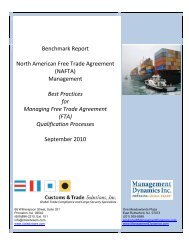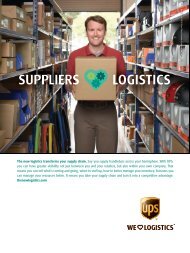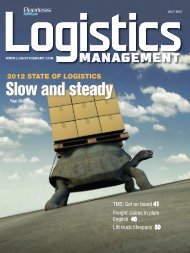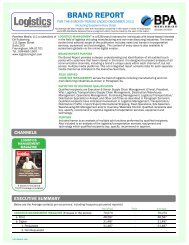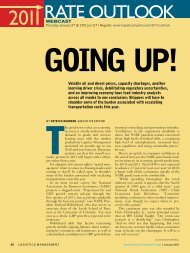Download - Logistics Management
Download - Logistics Management
Download - Logistics Management
Create successful ePaper yourself
Turn your PDF publications into a flip-book with our unique Google optimized e-Paper software.
2012 SUPPLY CHAIN VIRTUAL CONFERENCE<br />
Now ON-DEMAND @ logisticsmgmt.com/global2012<br />
“ Nobody has yet taken out<br />
all of the excess costs in<br />
supply chains. Opportunities<br />
for improvement continue<br />
to exist.”<br />
—Jeanne Dailey, Accenture<br />
Those companies that do make the<br />
connection between technology and<br />
global trade compliance don’t always<br />
make the best decisions around business<br />
case and vendor selection. For<br />
example, Peterson highlights some of<br />
the worst practices in global trade management<br />
(GTM) as follows: Looking at<br />
automation as a “cure-all” for woes of<br />
non-existent or inefficient processes;<br />
capturing hidden costs such as delays,<br />
handling and service charges, duty<br />
advancement fees, and bond charges;<br />
and allowing financial models to trump<br />
compliance requirements.<br />
To avoid these challenges, Peterson<br />
says that a better approach includes<br />
measuring cost versus benefit; benchmarking<br />
with other companies; cleansing<br />
and protecting your data; thinking<br />
beyond borders and companies; and<br />
assembling a cross-functional team to<br />
handle the software selection, implementation,<br />
training, and other functions<br />
associated with the GTM.<br />
Taking an initial, introspective look<br />
at the company’s current processes and<br />
resources before integrating technology<br />
into the global compliance mix is<br />
equally as important. “The biggest mistake<br />
[companies] make is they implement<br />
a solution without even beginning<br />
to measure what they were doing before<br />
they implemented it,” Peterson adds.<br />
Session 2: How to cut global logistics<br />
and transportation costs<br />
As the global economic recovery continues<br />
to inch forward, shippers are starting<br />
to see shrinking capacity and higher<br />
rates across all transportation modes.<br />
In this session, Accenture’s Jeanne<br />
Dailey, senior principal, and Brooks<br />
Bentz, partner, discuss the trend and<br />
offer attendees practical steps for gaining<br />
more control of their transportation<br />
budgets and overall operations.<br />
According to Dailey and Bentz, various<br />
forces are affecting supply chain<br />
behavior right now. Permanent volatility<br />
is becoming the “new normal,” they say,<br />
and what used to work well for companies<br />
will not suffice in the future. Not<br />
only are supply chains more extended,<br />
global, complex, and more demanding,<br />
but transportation costs now exceed 63<br />
percent of total supply chain costs.<br />
To deal with these current challenges,<br />
and those that rear their heads<br />
in the future, Dailey and Bentz say<br />
companies will need to have dynamic<br />
operations and agility. “Nobody has yet<br />
taken out all of the excess costs in supply<br />
chains,” says Dailey. “Opportunities<br />
for improvement continue to exist.”<br />
A few of the common practices that<br />
companies are using today include<br />
conducting sourcing events for select<br />
carriers and modes; keeping a limited<br />
number of carrier contracts in place<br />
and performing limited auditing on<br />
those carriers; using decentralized and<br />
manual shipment planning and execution;<br />
and relying on a limited number<br />
of transportation management systems<br />
(TMS) and other logistics tools.<br />
“Just how shippers operationalize<br />
their supply chain functions depends<br />
on their capabilities and chosen operating<br />
models, frequently varying by<br />
industry and geography, even within the<br />
same organization,” says Bentz. Both<br />
Bentz and Dailey point out that the<br />
roller coaster of events of the last few<br />
years left an “unprecedented change<br />
in how transportation is managed and<br />
brought havoc to logistics budgets and<br />
attention at the highest levels of organizations.”<br />
The good news is that the decline in<br />
rates has provided much needed relief to<br />
cost pressures. “With the recession fading<br />
and volumes returning, the rate of<br />
change in transportation costs will likely<br />
revert to the increased upward pressure<br />
on rates,” says Bentz. “This rate of<br />
change and the complexity of transportation<br />
make granularity and visibility of<br />
information and the tools which enable<br />
it paramount in controlling costs and<br />
maintaining service levels.”<br />
Session 3: Taking a collaborative<br />
approach to ocean shipping<br />
Many companies find it difficult to collaborate<br />
effectively with third parties<br />
that are in close geographic proximity<br />
to their own hubs, let alone across the<br />
86 LOGISTICS MANAGEMENT WWW.LOGISTICSMGMT.COM | December 2012




